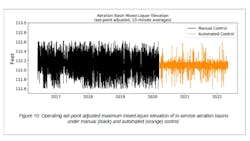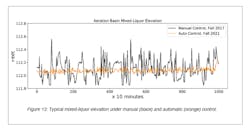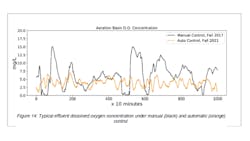Manual control vs. automation for dissolved oxygen concentration
Manually controlling water and wastewater treatment processes — such as those performed by aeration basins — typically creates significant operational variations that translate into reduced efficiency, higher costs and lower performance. A U.S. water authority recognized a correlation with excessive oxygen utilization and existing manual controls, and therefore prioritized control of the aeration basin mixed-liquor depth and the effluent dissolved oxygen (DO) concentration as the main targets for automation.
This U.S. water authority’s experience validates how automation can drive more efficient and cost-effective operations while providing additional benefits of decreasing energy and chemical use. Specifically:
- Introducing automated balancing of mixed-liquor effluent flow in response to upstream process adjustments reduced in day-averaged mixed-liquor depth interquartile range (IQR) by 74%.
- Subsequent automation of aeration basin oxygen feed controls reduced variation in the day-averaged effluent DO IQR by as much as 59%.
- Annual oxygen usage in the secondary treatment process was reduced by 30%, translating into a $1.01 million per year reduction of annual oxygen costs at 2019 rates.
Example of manual control at a wastewater plant
The plant referred to in this case study has primary and secondary treatment capacities of 1,700 and 930 million gallons per day (mgd), respectively. The facility’s secondary treatment equipment consists of four high-purity oxygen aeration basins (A1, A2, A3, and A4) along with 25 circular clarifiers.
Aeration basin volume and flow
Each aeration basin has a volume of approximately 17.8 million gallons. Flow to the basins is supplied by lift pumps, with the flow rate to each basin determined by upstream process demands. The basins are arranged in parallel, with three of the four basins in service at a given time. Each basin operates at an average influent flow of 226 mgd, with peak flow at 310 mgd per basin in wet weather. Return activated sludge (RAS) from the secondary clarifiers flows into the head of each basin is between 40 to 50 mgd. Flow meters measure the influent and RAS flow to each basin.
Internally, each of the four basins is segmented into ten (A1 and A2) or eight (A3 and A4) bays arranged in series from influent (bay 1) to effluent (bay 8 or 10). The bays within each aeration basin are connected via staggered openings that produce a snaking mixed-liquor flow pattern. Typical detention times are between 1.2 and 2.2 hours.
Wastewater depth is measured in real-time by differential pressure transmitters located in each basin. Each basin has a sidewall depth of 34 feet and operates with a mixed-liquor depth of approximately 30 feet (112.1-foot elevation).
The oxygen necessary for microbial digestion of organic material is supplied from a common source line which divides to enter the headspace (i.e. above the waterline) of each basin at bay 1. Each basin is equipped with a butterfly valve and motorized actuator, allowing for independent oxygen flow rate control. Oxygen flows are measured at the common supply and at the feed valve to each basin.
Importance of mixers for dissolved oxygen (DO) profile
Surface aerators with submerged mixer impellers (mixers) transfer headspace oxygen into the liquid, increase contact between the microorganisms and organic matter, and promote a DO profile that is uniform through the depth of each bay. The DO content of the mixed-liquor is continuously measured by a luminescent dissolved oxygen probe submerged below the waterline of each basin’s final bay. Each bay in A1 and A2 is equipped with up to two mixers, while the bays in A3 and A4 have up to four mixers each.
All available mixers are operated continuously to ensure adequate oxygen transfer throughout the length of each basin. Each mixer’s current and load are continuously monitored as indicators of mixed-liquor depth control upsets. Increasing or decreasing current and load are indicators of rising or falling depth. To maximize headspace-to-liquid oxygen transfer, the mixed-liquor surface must make sufficient contact with each aerator blade. At low mixed-liquor depth, the blades do not sufficiently contact the liquid, while at high mixed-liquor depth, the blades can be submerged below the liquid. Either condition produces poor oxygen transfer and high variation in the measured effluent D.O. concentration.
For optimum biological growth and digestion of organic material, the effluent DO concentration of each basin must be maintained between 2 to 4 mg/L. Low D.O. concentrations promote the growth of undesired (filamentous) bacteria, while high DO due to over-supply of oxygen is an indicator of excess process costs.
Operating within the target DO concentration range requires both precise control of the mixed-liquor depth, and appropriate flow of oxygen into the headspace of each basin. While the motorized oxygen-flow valves provide a direct means of controlling the oxygen flow to each basin, control of the mixed-liquor depth is indirect, relying on the modulation of the total flow into the secondary clarifiers.
Return activated sludge and secondary clarification
Gravity drives flow from the aeration basins (surface elevation approximately 112 inches) into the secondary clarifiers (inlet elevation 92.3 inches) through shared discharge channels. Each of the 25 secondary clarifiers (combined surface area is 785,000 square feet, with an average influent flow of 27 MGD per clarifier) is equipped with a motorized butterfly valve enabling control of the influent flow rate. Each clarifier is equipped with a RAS pump that recirculates settled sludge to inflow channels leading to bay 1 of each aeration basin. Typical RAS flow rates (per clarifier) are between 5-6.5 MGD. Dedicated magnetic flowmeters provide a measurement of each clarifier’s influent and RAS flows.
Manual vs. automated control for wastewater
Before automation, the secondary clarifier influent valves were operated in a leader-follower mode, with manual adjustments made ‘as needed’ to a single lead clarifier mirrored by the follower clarifiers. The timing, magnitude, and direction of clarifier valve adjustments were determined based on several factors including the upstream (primary) flow, mixer currents and loads, aeration basin mixed-liquor depths, and anticipated process changes. Effective manual control required:
- Simultaneously monitoring multiple process parameters;
- Properly anticipating emerging trends;
- Understanding the impact of clarifier valve position on aeration basin mixed-liquor depths; and
- Frequent adjustment – making proper control inherently challenging and prone to disturbance and high variability.
With DO concentration closely linked to mixed-liquor depth control, the limitations of manual depth control amplified the challenge of manual oxygen feed control. Historically, oxygen supply to each basin was adjusted ‘as needed’ based on a real-time trend of the effluent DO concentration. The time between an oxygen supply adjustment and its observed impact on the effluent DO can be more than five hours. Therefore, effective manual DO control required an understanding of the relationship between the present oxygen flow and the future D. concentration. Combined with oxygen demand increases and decreases driven by highly variable mixed-liquor depth, this produced sub-optimal DO control, characterized by frequent over-correction.
Secondary controls automation was introduced in two phases with the goal of reducing variation and excess oxygen use:
- Phase One: Automating aeration basin mixed-liquor depth control through influent effluent flow balancing.
- Phase Two: Automating aeration-based effluent DO concentration control through model predictive control (MPC).
Phase one: optimized depth control strategy
Analyzing historical process data and direct response-testing using the existing manual controls led to the adoption of a feedforward and feedback automation strategy based on flow-balancing. The flow-balance controls manipulate a common flow setpoint for each of the clarifiers. As level control is an integrating process, the mixed-liquor depth will rise or fall unless the inflow to the aeration basins matches the outflow, making the feedforward portion the primary means of control.
The feedforward loop trims the flow setpoint to compensate for flow imbalances arising during transient events and other process disturbances. Setpoint adjustments are determined based on mass balance as the sum of the total aeration basin influent — equal to the primary effluent plus the RAS flow — changes. The setpoint is adjusted to match the new influent flow.
Feedback consists of two proportional–integral–derivative (PID) loops, the first of which operates based on the maximum value of the available aeration basin level transmitters. The second feedback, the override circuit, utilizes the maximum of the basin-averaged mixer motor currents. In each control cycle, the highest output of the two feedback loops is selected and added to the feedforward loop.
The override circuit protects against high-depth upset events, overriding the normal behavior of the flow balance controls in scenarios where the mixed-liquor depths rise towards the programmed mixer high-load protection trip setpoint. At normal depths and mixer loads, the override PID winds down to zero, leaving only the level-transmitter loop active. To enable precise control, only 15 of the 25 clarifiers are placed in flow-balance mode, with the remaining operating with a constant inflow.
Phase two: DO control strategy
Due to the time lag between oxygen flow rate adjustment and the effluent DO concentration response, automating aeration basin DO control utilized a model-based predictive control strategy with DO concentration feedback.
Model predictive control (MPC) is a control technique where a control sequence is solved from the optimization of a quadratic cost function over a prediction horizon at each sampling time. Only the first control move in the sequence is applied, and the whole optimization process repeats at the next sampling time.
Advantages of model predictive control
One of the major advantages of MPC is its ability to handle process constraints explicitly. MPC is inherently a high-order controller which makes it an ideal candidate for dealing with high-order process dynamics, such as the dynamics induced by large pure time delay. The MPC controller produces an oxygen flow setpoint, which is transferred to an inner oxygen valve PID control loop (in cascade) that determines the oxygen flow valve setpoint. The DO response to changes in oxygen flow rate was modeled based on historical process data limited to periods of stable process conditions (for example, constant wastewater flow, temperature, etc.) where the DO to oxygen flow relationship was more easily determined.
The use of historical data eliminated the need for open-loop step response testing. Using the modeled response, two process feedforwards (temperature and influent flow, described below), and the DO feedback, the MPC determines the optimal series of oxygen flow adjustments required to minimize the deviation between the predicted DO trajectory and the target DO setpoint over a five-hour horizon. The first of these adjustments is forwarded to the valve control PID each control cycle.
How feedforward automation works
The mixed-liquor temperature and aeration basin influent flow including RAS serve as feedforward inputs to the MPC, adjusting its output in response to live conditions in the basin. The feedforwards were selected based on modest correlation with the supplied oxygen flow as determined by analysis of historical data. Identical logic was implemented for each aeration basin, with basin-specific tuning and setpoint optimization performed during initial control testing.
Two layers of constraint ensure that the DO control logic always provides appropriate oxygen to the aeration basins. The constraints (hard and dynamic) prevent over or under supply of oxygen in case of DO probe failure or erroneous low or high concentration readings. Hard limits prevent the MPC output oxygen flow setpoint from rising below or above seasonally adjusted bounds — for example, higher in summer and lower in winter.
Dynamic limits are computed for each control cycle based on the real-time mixed-liquor temperature and aeration basin influent flow. Historical process data was used to determine a model of the 20th and 80th percentile oxygen flows as a function of the temperature and flow. The MPC output is constrained to fall between the maximum (minimum) of the hard and dynamic lower (upper) bounds.
Results
Automated flow balancing and dissolved oxygen controls have substantially reduced in-process variation and oxygen consumption.
The combined oxygen flow rate to the aeration basins decreased from a baseline of 166 KSCF per hour under manual control to an average of 114 KSCF per hour under full automation. This reduction in oxygen usage represents a cost reduction of $1.01 million each year at 2019 rates when compared to the 2011-2019 baseline of $3.42 million per year.
Conclusions
Automating flow balance and oxygen supply controls substantially reduced process variation and oxygen consumption. These reductions were achieved without negatively affecting downstream wastewater treatment metrics and did not require new treatment infrastructure or instrumentation.
It has been determined that further improvement could be achieved using advanced diagnostic algorithms capable of detecting a malfunction of key control elements, for example, dissolved oxygen probes, level transmitters and mixer motors; and by incorporating additional process data, such as headspace oxygen purity and additional DO probes located mid-basin.
About the Author
Michael Painter
Business Development Manager, Emerson
Michael Painter is a business development manager for Emerson.




